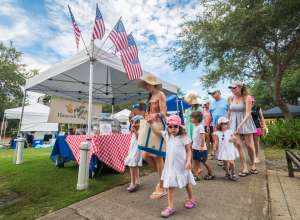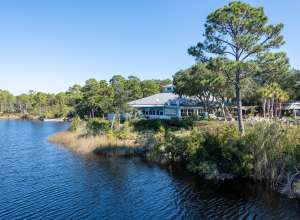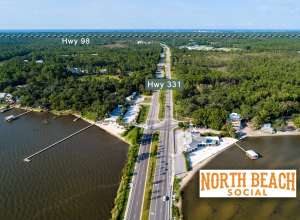Story
South Walton Lifeguards Train to Save Lives
April 24, 2012 by Tom McGee

While standing in waist-deep water off a beach in South Walton County, one where no lifeguard was on duty and no flags warned me of danger, a RIP CURRENT whisked me out to sea, tumbling me over and over like a washing machine. Because of training I had received as a Scuba diver, I was aware of what was happening to me and able to extricate myself from the danger. Having had this terrifying experience twenty years ago, I was happy to be invited to observe a week of lifeguard training in South Walton County and write this story.
These brave young men and women came from all walks of life. Their bond was a desire to attain the United States Life Saving Association (USLA) certification as an Open Water Lifeguard. Then they aspired to work for the South Walton Fire District (SWFD) as Open Water Lifeguards. They had already worked hard to receive the pre-required certifications of First Responder and CPR.

While speaking with Fire Chief Rick Talbert about doing a story on beach safety, he put me in touch with Gary Wise, the Director of the SWFD Beach Safety Program. When we met, Gary’s hands were chafed from spending the previous day in an offshore paddling competition, where he and his crew paddled into headwinds for almost fifteen straight hours to cover sixty-eight miles. I traveled to Ed Walline Park on the first Monday of March where, during a week of training, new recruits would perform sixteen hours of open water drills in hopes of attaining their USLA Open Water Certifications. Returning guards were on the beach to help the new recruits and to put in their sixteen hours of training for their annual re-certifications.
The Walton County Tourist Development Council funds the Beach Safety Program through a contract with SWFD to provide for beach safety services. As I watched, a substantial surf provided Gary with the conditions he wanted to begin training new recruits and re-training his returning guards. Later, Gary would tell me that his lifeguards would continue to train at least once a week during the season. "Our season runs from the second week in March until the last Sunday in September," he explained.
 Gary explained that once training is completed this year we will have approximately thirty USLA Open Water Certified Life guards manning eight towers along our beaches. The locations of the towers have been chosen by the County, at public accesses that have the bathroom amenities the guards will need during an eight hour shift. Contractually, the SWFD’s area covers only the public beach access areas, but history has shown that over 90% of rescues have occurred outside the SWFD’s primary zone of responsibility. In 2008 two rescues occurred in the primary zones, while 101 rescues were performed in secondary zones. In 2011, four rescues occurred in primary zones and 29 tin secondary zones. Each tower will be manned by two guards from 10:00 a.m. until 6:00 p.m. daily. Gary observed, “Considering that we only have eight lifeguard stations to cover 26 miles of beach, this means that our guards have to travel great distances on dune vehicles or Personal Flotation Devices (PFD) to reach swimmers outside their primary area of responsibility."
Gary explained that once training is completed this year we will have approximately thirty USLA Open Water Certified Life guards manning eight towers along our beaches. The locations of the towers have been chosen by the County, at public accesses that have the bathroom amenities the guards will need during an eight hour shift. Contractually, the SWFD’s area covers only the public beach access areas, but history has shown that over 90% of rescues have occurred outside the SWFD’s primary zone of responsibility. In 2008 two rescues occurred in the primary zones, while 101 rescues were performed in secondary zones. In 2011, four rescues occurred in primary zones and 29 tin secondary zones. Each tower will be manned by two guards from 10:00 a.m. until 6:00 p.m. daily. Gary observed, “Considering that we only have eight lifeguard stations to cover 26 miles of beach, this means that our guards have to travel great distances on dune vehicles or Personal Flotation Devices (PFD) to reach swimmers outside their primary area of responsibility."
The first exercise required the nine rookies and eighteen veterans to swim through roaring surf 100 meters offshore in sixty degree water, then turn east and swim another 300 meters as hard as they could. The trainees then swam back to the beach and sprinted back to Gary to be timed and await further instructions. They returned breathless, but when they tried to drop in the sand to catch their breath, Gary, admonished in a firm Australian accent, “No, get up and walk around.” Gary explained, “If I let then lay on the wet sand after swimming in 60 degree water they would cramp up.”
As the day went on, I could see an esprit de corps and camaraderie developing. Rookie helped rookie. Veterans helped and pushed themselves and the rookies. They learned to porpoise through the breakers to save time. Entering the sixty degree water again and again depleted energy, but not spirit. They sprinted on the beach for hundreds of meters, then returned to sip water.
I watched these enthusiastic young men and women learn the hand signals necessary to communicate from the water to the shore. Some of the veterans would then go into the water and pretend to be victims while trainees assumed the role of rescuer. The guard on shore communicated by hand signals with the swimmers to show them where the “victims” were. This is necessary because swimmers in swells and breaking surf have a hard time spotting victims in the water. Once the victim was located, the swimmers would communicate to the guard on shore whether or not the victim was conscious so EMTS could be summoned.
Training became meticulous. The prospective guards learned precisely how to place the rescue boards at the ready on the sand. The learned how to exactly place the hard can life saving devices in the sand so they stood ready for immediate use. Over and over, the students practiced wrapping the lanyards properly around the tube and can life-saving devices so they would not tangle when they grabbed them to rush into the water for a rescue.

While the veterans and prospective lifeguards were doing their exercises in the water, Gary and I had a chance to talk. Gary is from Sydney, Australia where, like Walton County, they have twenty-six miles of beaches. Gary informed me that on the northern beaches in Sydney, lifeguard services during the week are performed by professional lifeguards. However, on the weekends, the members of twenty-one clubs--each with membership of a hundred or more--serve as lifeguards. Every club has its own clubhouse on the beach. Gary observed, “Of course, Sydney is a metropolitan area of five million plus souls. We do not have that amount of permanent population in South Walton to draw from for our recruits.”
Gary joined a surf club as a Nippe at age nine, before he became a lifeguard. In 1978, he pursued the necessary instruction and training to become an instructor . After Gary won the world lifesaving competition for Destin in 2002, Fire Chief Tuff Dixon of Destin approached him to advise on how to set up a beach safety program for Destin. Gary’s Destin program focused on education, prevention and rescue. Not long after advising on Destin’s program, Commissioner Cindy Meadows called Gary to ask him if he could do for Walton County what he had done in Destin. Gary replied, “Yeah, I can.” That was seven years ago.
Gary mentioned numerous times that, "Here in Walton County we want to emphasize education and prevention to reduce potential drownings." In 2011 lifeguards took 189,138 preventative actions, such as warning beach visitors of dangerous RIP CURRENTS or marine hazards in the water, that reduced the danger to swimmers. Gary further urged, “Yes, we want locals and visitors to enjoy the beautiful aqua/blue waters off the twenty-six miles of silver sand beaches that nature provided for us in South Walton County, but we also want them observe the flag warnings and the instructions and warnings that our lifeguards provide.”
When I asked Gary to describe deadly RIP CURRENTS, he provided me with a written description of these events :
+Waves pushing water across a sandbar into a channel.
+Water flows off the sides of a sandbar and into a channel or trough.
+The channel or trough is the path of least resistance for the water to flow back out to the deeper water or along the shore.
A SWFD publication instructs how to identify RIP CURRENTS as follows:
+Darker color indicates deeper water.
+Murky brown water is caused by sand stirred up off the bottom.
+Smaller unorganized waves, alongside more evenly breaking waves over a sand bar.
+Waves breaking further out to sea on both sides of the rip.
The publication further instructs what to do if you see someone caught in a rip:
+Notify a lifeguard.
+Have someone call 911 and give accurate location.
+DO NOT GET CAUGHT IN A RIP CURRENT TRYING TO SAVE SOMEONE ELSE. THROW THEM A FLOTATION DEVICE. A LARGE PERCENTAGE OF DROWNING VICTIMS ARE WOULD BE RESCUERS.
+Try not to lose sight of victim.
 Gary further advised that the best way to avoid a RIP CURRENT is to stay out of the water when the warning flags or lifeguards signal dangerous conditions. He reminded us that the County has gone to much effort and expense to create the flag warning system and provide lifeguards to disseminate information to the public. But the public must act responsibly.
Gary further advised that the best way to avoid a RIP CURRENT is to stay out of the water when the warning flags or lifeguards signal dangerous conditions. He reminded us that the County has gone to much effort and expense to create the flag warning system and provide lifeguards to disseminate information to the public. But the public must act responsibly.
By Wednesday, the rookies had gotten tougher and the water in the Gulf had gotten rougher. On this afternoon, I had a chance to speak to Ross Carter, one of the senior lifeguard instructors. The physically fit, thirty-eight-year-old Ross stood erect while talking to me, all the time observing his trainees preparing for their next exercise.
One of the older guards who will be on our beaches protecting us this year, Ross grew up in Savannah, Georgia on a 38 foot catamaran built by his dad. He, and his mom and dad lived aboard the homemade sailing vessel in ports throughout the Bahamas and the Yucatan. “I have always lived either on the water or never more than a mile from it. I could never live anywhere else,”Ross proclaimed.
When I asked Ross what attracted him to the lifeguard job, he replied, “For me, this job is all about doing something worthwhile in life with honor and a sense of service. It took me some time to get fit for the job and learn the skills necessary to do the job. This job has been a life changer for me. It is the best job I have ever had.”
When I asked about working as a team with the other guards, Ross beamed pride and said, “I have learned so much from Gary Wise and other members of the team. Outside my dad, Gary Wise has been the greatest influence in my life.”

Twenty-five-year-old Justin Cook has been with the Beach Safety Program since its inception seven years ago. Prior to coming to work for Gary, Justin endured the dangerous work on an offshore oil rig. Even after that life, Justin admits that it took some doing for him to get in shape for his duties as an open water lifeguard. When I asked why this job, Justin explained, “Getting in shape drew me to the program. Here I found a purpose--helping other people.” This year he is helping to train the nine new rookies.
Justin suggested that I speak with Brad Stewart, a Medal of Valor winner who has been with the program since the beginning. Brad came to the program after working in the more sedate world of being a manager at Winn Dixie. Brad humbly admitted he received the Medal of Valor for a rescue he participated in during May 2009, off the beach at Seagrove--just east of Eastern Lake.
Three people had gotten in trouble when they ignored the red flags and went into the Gulf, which was producing four to five foot swells. The victims were two miles to the east of Brad’s station. By the time Brad reached the terrified swimmers, one was unconscious and the other two were holding on to him. With no time to waste, Brad had to go into the dangerous surf alone. He struggled to tow all three men in and, once on dry sand, immediately commenced CPR on the unconscious man . Unfortunately, this victim could not be revived by the Fire Department paramedics who soon arrived on the scene.
Brad's experience at Seagrove demonstrates that when people ignore the flags and go into the water in dangerous conditions, they not only endanger themselves, they also put at risk the brave young men and women who have to come into the water after them.
When I asked Brad how he liked his job, he said, “Gary and the South Walton Fire District are great to work for. It is like having a second family.”
Graduation day for this group of veterans and rookies came on Friday. Before Gary and Chief Talbert handed out certifications and commendations, I had a chance to talk to the two women who completed this period of instruction.
Twenty-three-year-old Megan Ritacco holds a Bachelor’s Degree in political science from the University of West Florida. Tiny, but trim and fit, Megan is a triathlete. Even though Megan worked in Destin for the last two years as a USLA Open Water Certificated Lifeguard, she had to get re-certified because this was her first year to work for SWFD. In total, Megan has been a lifeguard for seven years.

Although Megan interned for a state senator for two years, she informed me that, “I had a romantic idea of politics. It was not what I thought it would be.” Megan says she prefers doing what she does now, “I like assisting people who have gotten in trouble in the water."
Regarding her training, Megan confides, “We all push and help each other. This agency is good about supporting us. There is a good team effort going on here.”
Megan emphatically states that their primary mission is to educate the public and prevent tragedy--rather than respond to it. She explains how much it hurts her to hear of some unskilled person drowning while trying to save someone else. “I wish they would they would pay attention to the warning flags and our warnings. When people go into the water in unsafe conditions, they put the lifeguards who have to rescue them at risk as well.”
Nineteen-year-old Dainelle Murzynsky, a student at FSU majoring in International Affairs and Middle Eastern Studies, received her USLA Open Water Certification on Friday of the training. When I asked her what motivated her to go through this strenuous program, Danielle said, “My dad is with the South Walton Fire District.” Danielle and her dad, Joe, beamed as they posed for a photo with Danielle holding her certificate of certification.
 Just before the ceremony, Dainelle proclaimed, “It was hard work. I had to complete my first responder and CPR work first.” She added, “The hardest part of the open water certification was the first five hundred meter open water swim.” She was able to complete the training because of “The amount of support by Gary and the training guards.”
Just before the ceremony, Dainelle proclaimed, “It was hard work. I had to complete my first responder and CPR work first.” She added, “The hardest part of the open water certification was the first five hundred meter open water swim.” She was able to complete the training because of “The amount of support by Gary and the training guards.”
When asked why she came to this job, Dainelle said, “The job is important because people’s lives are at stake,” Dainelle will be on duty on weekends until school lets out for the summer, when she will be in South Walton full time.
Before Gary and Chief Talbert handed out certificates, Gary addressed the lifeguards. He informed them that their training would continue weekly. He also mentioned that they would have some competitions with other lifeguard agencies to keep up their skills, but Gary ended by declaring, “These competitions are not our priority. Taking care of our beaches is our priority."
In talking with Gary and the Chief after the ceremony, they agreed that the training program has been a success, but it needs to be expanded to provide more protection along our twenty-six miles of beautiful beaches that attract so many people. They mentioned their junior lifeguard program which has been in existence for five years now. They hope to recruit future guards from this program. They also said they would like to secure more recruits from among locals and also from returning men and women veterans.
Anybody wishing to take on this worthy occupation should contact Director Gary Wise at the South Walton Fire District (850) 267-1298.























